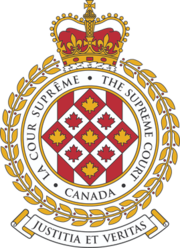
Back المحكمة العليا الكندية Arabic Oberster Gerichtshof von Kanada German Suprema Kortumo de Kanado Esperanto Corte Suprema de Canadá Spanish دیوان عالی کانادا Persian Kanadan korkein oikeus Finnish Cour suprême du Canada French בית המשפט העליון של קנדה HE Mahkamah Agung Kanada ID Corte suprema del Canada Italian
This article needs additional citations for verification. (May 2021) |
| Supreme Court of Canada | |
|---|---|
| Cour suprême du Canada | |
 | |
The flag of the Supreme Court (left) and the Cormier Emblem (right)[1] | |
 | |
| 45°25′19″N 75°42′20″W / 45.42194°N 75.70556°W | |
| Established | 8 April 1875 |
| Jurisdiction | Canada |
| Location | Ottawa, Ontario |
| Coordinates | 45°25′19″N 75°42′20″W / 45.42194°N 75.70556°W |
| Composition method | Judicial appointments in Canada |
| Authorized by | Constitution Act, 1867 and Supreme Court Act, 1875 |
| Judge term length | Mandatory retirement at age 75 |
| Number of positions | 9 |
| Website | www |
| Chief Justice of Canada | |
| Currently | Richard Wagner |
| Since | 18 December 2017 |
| Lead position ends | 2 April 2032 |
| Part of a series on |
| Canadian law |
|---|
 |
The Supreme Court of Canada (SCC; French: Cour suprême du Canada, CSC) is the highest court in the judicial system of Canada.[2] It comprises nine justices, whose decisions are the ultimate application of Canadian law, and grants permission to between 40 and 75 litigants each year to appeal decisions rendered by provincial, territorial and federal appellate courts. The Supreme Court is bijural, hearing cases from two major legal traditions (common law and civil law) and bilingual, hearing cases in both official languages of Canada (English and French).[3]
The effects of any judicial decision on the common law, on the interpretation of statutes, or on any other application of law, can, in effect, be nullified by legislation, unless the particular decision of the court in question involves application of the Canadian Constitution, in which case, the decision (in most cases) is completely binding on the legislative branch. This is especially true of decisions which touch upon the Canadian Charter of Rights and Freedoms, which cannot be altered by the legislative branch unless the decision is overridden pursuant to section 33 (the "notwithstanding clause").
- ^ a b "Description of Heraldic Emblems". Supreme Court of Canada. 15 March 2021. Archived from the original on 9 July 2021. Retrieved 9 July 2021.
- ^ "Role of the Court". Supreme Court of Canada. 23 May 2014. Archived from the original on 5 August 2014. Retrieved 27 May 2014.
- ^ Government of Canada, Department of Justice (15 April 2008). "Harmonization of Federal Legislation with the Civil Law of the Province of Quebec - Booklet 1". www.justice.gc.ca. Retrieved 18 November 2024.
